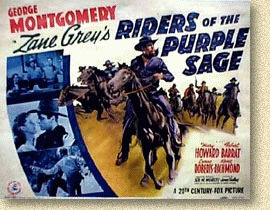|
ZGWS News

Special
Features

Collectors’s
FAQs

Zane
Grey on Film

Geography
of his Writings

Zane
Grey Museums

Member
Dealers, Artists, & Authors


Come join us on Facebook!

Visit our YouTube Channel!

|
|
Home
>
Special Features >
Zane Grey's Riders of the Purple Sage

 Zane Grey's
Zane Grey's
Riders of the Puple Sage

by Marian Kester Coombs, ZGWS
Riders of the Purple Sage, published in 1912, was Zane Grey's first
best-selling novel of the many he was eventually to pen. It has never been
out of print, is a solid entry in the canon of American literature and is
considered one of the best Westerns ever written, if not the best of them
all. Yet it is rarely read today by the general public, and still less
read are the several dozen arguably greater books that Grey published up to
his death in 1939 and that Harper & Brothers issued posthumously well into
the 1950s. His once-hailed name had by the 1960s become a laughable cliche
synonymous with the B Western genre and its cast of overplayed,
underdeveloped characters --- taciturn gunslingers, stock villains,
fainting females, noble or bloodthirsty savages --- all rolling dutifully
along in the dusty ruts of interchangeable plot lines. "Serious" critics,
ever mistrustful of the popular taste and loathing "idealism" of any
(except the Soviet) sort, had of course never cared for Zane Grey. The
coup de grace to his reputation was the scores of cheaply made Western
films cranked out by Hollywood in the 1920s, '30s and '40s which traded on
his titles and derived little else of substance from their namesakes.
 Thus
it was with some curiosity that one heard of Turner Network Television's
remake of Riders of the Purple Sage, filmed near Moab, Utah, and
aired in January 1997. But it is with considerable astonishment
that one opens the novel itself and finds there beautiful writing,
geologically precise nature description, diverse and memorable characters,
a moving inner struggle to reconcile deeply held beliefs with odious
social practice, and a rousingly exciting story that moves swiftly
across hundreds of pages to an unforgettable ending. Thus
it was with some curiosity that one heard of Turner Network Television's
remake of Riders of the Purple Sage, filmed near Moab, Utah, and
aired in January 1997. But it is with considerable astonishment
that one opens the novel itself and finds there beautiful writing,
geologically precise nature description, diverse and memorable characters,
a moving inner struggle to reconcile deeply held beliefs with odious
social practice, and a rousingly exciting story that moves swiftly
across hundreds of pages to an unforgettable ending.
Jane Withersteen is the proud young inheritor of her Mormon
father's hard-won ranch-oasis in the Utah desert. "Her clear sight
intensified the purple sage slope as it rolled before her. Low swells of
prairie-like ground sloped up to the west. Dark, lonely cedar trees, few
and far between, stood out strikingly, and at long distances ruins of red
rock. Farther on . . . rose a broken wall, a huge monument, looming dark
purple and stretching its solitary, mystic way, a wavering line that faded
in the north. Here to the westward was the light and color and beauty.
Northward the slope descended to a dim line of canyons from which rose an
upflinging of the earth, not mountainous, but a vast heave of purple
uplands with ribbed and fan-shaped walls, castle-crowned cliffs, and grey
escarpments. Over it all crept the lengthening, waning afternoon shadows."
As the book opens, Jane is under great pressure from the elders of
the Mormon church to become one of the multiple wives of Elder Tull; to
show they mean business, they have run down one of her Gentile cowboys,
Venters, and are about to whip him and drive him from the territory. Into
this scene rides Lassiter, famed and feared as a scourge of Mormons for
motives unrevealed until later. Lassiter stays on as a rider for the
increasingly harassed and isolated Jane, who tries to soften and disarm him
by feigning she has fallen in love with him. Even as the dread evidence of
Mormon revenge mounts --- the rustling and stampeding of her cattle, the
defection of her hands and servants --- she strives to "melt his heart"
toward Mormons. But her success nearly dooms them both.
As the showdown with the elders approaches, Lassiter rearms:
"Where would any man be on this border without guns? . . I'd be under the
sage with thousands of other men now livin' an' sure better men than me."
They shoot it out with bands of Mormons, escape with an orphaned child on
wind-swift horses toward the bewildering maze of Deception Pass, following
a trail left by Venters and the mysterious girl he has inadvertently
rescued from a rustler gang, and then . . . Suffice it to say that the
millions who read Riders of the Purple Sage when it first appeared were
exceedingly grateful for the sequel published three years later, The
Rainbow Trail, and so will the modern reader be.
 Riders is in some ways unlike many of Zane Grey's other books. The writing is less naturalistic, more formally "literary," and the (still controversial) anti-Mormon sentiments here are in contrast with the very sympathetic portrayal of Mormons in, for example, The Heritage of the Desert (1910). The hero Lassiter, while clearly the prototype for hundreds of novelistic and cinematic imitators, is also atypical of Grey, most of whose main male characters are disheartened young Easterners who flee or drift West in a final effort to attain manhood and selfhood. Once initiated into the harsh, elemental Western environment, they come to "know a happiness that dwells in the wilderness alone" and make something real of themselves at last. His heroines are usually spirited but discontented Eastern girls who undergo rites of passage every bit as rigorous as their masculine counterparts'. Riders is in some ways unlike many of Zane Grey's other books. The writing is less naturalistic, more formally "literary," and the (still controversial) anti-Mormon sentiments here are in contrast with the very sympathetic portrayal of Mormons in, for example, The Heritage of the Desert (1910). The hero Lassiter, while clearly the prototype for hundreds of novelistic and cinematic imitators, is also atypical of Grey, most of whose main male characters are disheartened young Easterners who flee or drift West in a final effort to attain manhood and selfhood. Once initiated into the harsh, elemental Western environment, they come to "know a happiness that dwells in the wilderness alone" and make something real of themselves at last. His heroines are usually spirited but discontented Eastern girls who undergo rites of passage every bit as rigorous as their masculine counterparts'.
Grey was a born storyteller; the first books he ever wrote were
stirring novelizations of the exploits of his own pioneer ancestors, the
Zanes of the Ohio Valley (Betty Zane, The Spirit of the Border and The Last
Trail, in 1903, 1906 and 1909 respectively). One insightful critic
likened him to a "maker of the sagas of the folk." Ridiculed by the
nascent Modernists for his romanticism, Grey retorted, "To my mind, romance
is only another name for idealism; . . . the spirit, not the letter, of
life." The "letter," however, was also keenly observed: Grey researched,
tramped, traversed and inhabited every region of the West he wrote about,
often husbanding the seeds of a tale for years before bringing them to
fruition. A biographer states that Grey wanted "his readers to feel the
thrill of adventure as he felt it, to see each scene and to sense the
atmosphere as vividly as if they were accompanying him on each expedition,"
and that says it.
Readers of today would do well to allow neither the animus of
long-forgotten critics nor the misbegotten knock-offs of Hollywood to
prejudice them against great stories, great writing and a great American
author.
ZGWS member Marian Kester Coombs lives in Crofton, Maryland, with her husband Fran, who is , currently a consultant for Rasmussen Reports. The Coombses have two grown daughters.

Home
>
Special Features >
Zane Grey's Riders of the Purple Sage
Historical images of Zane Grey used with permission of Dr. Loren Grey
|
|
|
|

